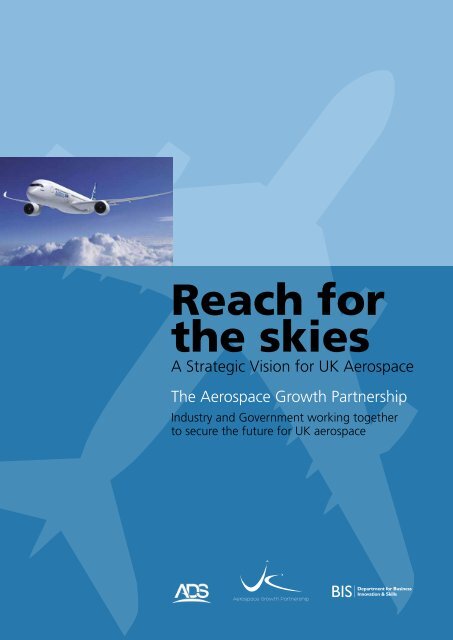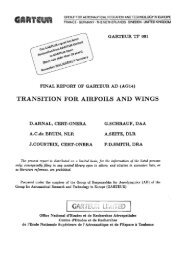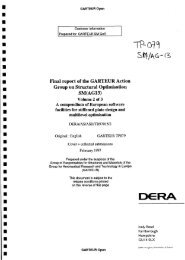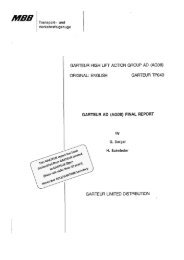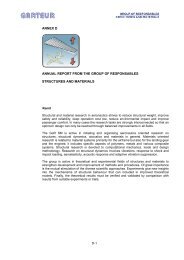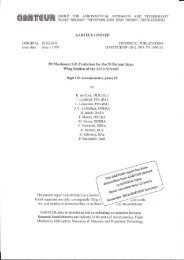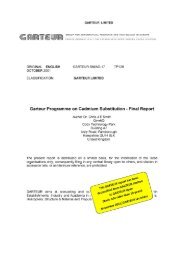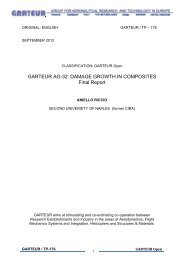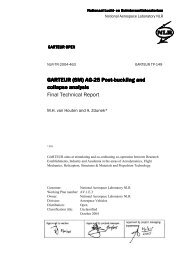Aerospace Growth Partnership - AgustaWestland
Aerospace Growth Partnership - AgustaWestland
Aerospace Growth Partnership - AgustaWestland
You also want an ePaper? Increase the reach of your titles
YUMPU automatically turns print PDFs into web optimized ePapers that Google loves.
Reach for<br />
the skies<br />
A Strategic Vision for UK <strong>Aerospace</strong><br />
The <strong>Aerospace</strong> <strong>Growth</strong> <strong>Partnership</strong><br />
Industry and Government working together<br />
to secure the future for UK aerospace
Industry and Government working together to secure the future for UK aerospace<br />
Prime Minister’s<br />
Foreword<br />
Britain has a proud record of aerospace achievements, from the invention of<br />
the jet engine to making the wings on the largest commercial aircraft in service today.<br />
Our industry is the largest in Europe; a direct employer of more than 100,000 people;<br />
and a powerhouse in the UK economy, with a turnover of more than £20 billion a year.<br />
It is, quite simply, a phenomenal success story. But there must be no complacency.<br />
The huge potential in the global market – for trillions of pounds worth of new orders<br />
in less than twenty years – means that competitors around the world are investing and<br />
preparing the ground today. Britain must show the same foresight.<br />
That’s what the <strong>Aerospace</strong> <strong>Growth</strong> <strong>Partnership</strong> is all about. We heard from industry that<br />
you wanted long-term commitment from government, without long-term hassle and<br />
interference. So the partnership was born; a chance for those in Whitehall to work with<br />
those in business to tackle the challenges facing UK aerospace. The group has been<br />
looking at what technologies, skills and supply chain changes we need to make – not just<br />
to retain our position in the market but to build on it.<br />
This report is just the start. We will return with a fuller strategy at the end of year –<br />
and beyond that, we are determined to work hand-in-glove with industry to keep UK<br />
aerospace flying high.<br />
Reach for the skies | 1
Industry and Government working together to secure the future for UK aerospace<br />
<strong>Aerospace</strong> <strong>Growth</strong> <strong>Partnership</strong><br />
Industry and Government working together<br />
to secure the future for UK aerospace<br />
Vince Cable<br />
Secretary of State for Business<br />
The UK aerospace industry is a big success story. We have the top aerospace<br />
industry in Europe, and we are a lead supplier to the world’s aerospace<br />
market. We intend to keep it that way, but we can’t be complacent.<br />
Competition is increasing around the globe and it’s important we remain<br />
at the forefront of technology, manufacturing capability and skills.<br />
The Government has embarked on a strategic partnership with business to<br />
deliver growth in aerospace and I look forward to us achieving that.<br />
Mark Prisk<br />
Minister for Business and Enterprise<br />
I welcome this strategic vision for aerospace because this is a sector that offers<br />
tremendous opportunities for growth. The <strong>Aerospace</strong> <strong>Growth</strong> <strong>Partnership</strong><br />
represents a new chapter in the way the aerospace industry is prepared to<br />
work collectively and with Government to tackle barriers to growth, boost<br />
exports and grow the number of high value jobs. This document sets out<br />
key areas where we can build on our strengths in aerospace and broaden our<br />
customer base. I am confident that this is a sector that will help the UK earn<br />
its living in advanced manufacturing for a long time to come.<br />
Marcus Bryson<br />
CEO GKN <strong>Aerospace</strong> and Land Systems, and ADS VP for Civil <strong>Aerospace</strong><br />
Close cooperation between industry and Government is vital to securing<br />
the future for the UK aerospace sector. That is why the AGP is a timely and<br />
welcome initiative. It is a true partnership, with the best talent in industry and<br />
Government working closely together to plot the way ahead. There are great<br />
opportunities ahead for the civil aerospace sector. But there are also threats. For<br />
both of those reasons, now is the right time for us to be devoting our collective<br />
efforts to what is one of our greatest industrial assets – the aerospace sector.<br />
2 | Reach for the skies
Industry and Government working together to secure the future for UK aerospace<br />
Executive summary<br />
By working together across Government and industry, the AGP’s vision is to:<br />
• Ensure that the UK remains Europe’s largest aerospace manufacturer and<br />
globally keeps its position as second only to the US. This is an ambitious and<br />
challenging goal, given intensifying international competition and the rapid<br />
pace of innovation in the sector.<br />
• Support UK companies at all levels of the supply chain to broaden and<br />
diversify their global customer base. This will be critical given the entry into the<br />
market of new manufacturers of large civil aircraft.<br />
Context<br />
The UK has 17% of the global market for aerospace. This makes us the largest aerospace industry in<br />
Europe and globally second only to the United States. The sector provides over 100,000 direct jobs<br />
and indirectly supports many more across the UK. It generated £24.2bn of UK revenue in 2011 - 75%<br />
of which was exported. Much of this current success results from investment made in research and<br />
technology over a number of decades, particularly in the 1970s and 1980s.<br />
The UK has particular capabilities in the most complex parts of the aircraft. About half of the world’s<br />
modern large aircraft fly on wings manufactured in the UK. A Rolls-Royce powered aircraft takes off<br />
somewhere in the world every two and a half seconds. UK companies also have world-class strengths<br />
in advanced systems (such as landing gear, actuation, avionics, fuel and power supply), and deliver<br />
innovative new ways of providing services such as maintenance, repair and overhaul. In addition,<br />
the UK is one of only a handful of nations with the range of capabilities needed to design and build<br />
advanced helicopters.<br />
Recent investments by industry have created world-class facilities such as the new Airbus A350<br />
wing factory at Broughton in North Wales, GKN’s advanced wing component facility near Bristol,<br />
Rolls-Royce’s new engine-blade casting facility at Rotherham, Bombardier’s composite wing<br />
facility in Belfast and Spirit AeroSystems’s new composite development centre in Prestwick. The<br />
Government announced in March 2012 a £60m new investment to create a new UK virtual centre<br />
for aerodynamics, in addition to funding for research into new engine manufacturing techniques and<br />
low-emissions engine technology.<br />
However, the UK is facing stiff global competition with not only established aerospace nations, but<br />
also an increasing number of developing aerospace nations who are investing heavily in technology,<br />
skills and supply chains, with strong support from their governments in order to acquire market share.<br />
Reach for the skies | 3
Industry and Government working together to secure the future for UK aerospace<br />
“<strong>Aerospace</strong> is a key sector for GE in the UK and we are pleased to be<br />
delivering cutting edge UK technologies to our customers worldwide.<br />
We believe aerospace plays a crucial role in the growth story and will be<br />
pivotal in turning the economy around. We are delighted to be working<br />
actively in the AGP, which is clearly doing valuable work to ensure<br />
conditions are right for growth.”<br />
Mark Elborne - President & CEO, GE UK and Ireland<br />
In order to achieve the necessary improvements in environmental impact and operating costs,<br />
the next generation of aircraft will be based on radically different technologies, requiring new<br />
manufacturing processes and placing new challenges on the UK supply chain if it is to remain<br />
globally competitive.<br />
Potential for <strong>Growth</strong><br />
Since the 1970s, growth in air travel has proved remarkably resilient against economic shocks.<br />
The global market outlook for aerospace presents some early major opportunities for UK<br />
companies. This ranges from work to refresh, upgrade and stretch variants of existing aircraft<br />
programmes, through to exceptionally promising opportunities on all-new next generation<br />
platforms likely to enter service in the middle of the next decade.<br />
It is forecast that nearly 27,000 new large civil airliners (with a market value of $3.2 trillion) will<br />
be needed by 2030 and by 2020 there will be a global market for around 9,500 civil helicopters<br />
(worth around $50bn).<br />
Key Strategic Findings<br />
Government and industry will continue to work together to develop the AGP’s vision into a detailed<br />
strategy. This will draw on the following key findings from the initial stages of the AGP’s work:<br />
• The UK can retain its position as the largest aerospace manufacturer in Europe (and number two<br />
globally), if industry and Government work together to address barriers to growth.<br />
• The UK aerospace industry can differentiate itself from competing nations by developing product<br />
and process technologies now that secure market share in the short and medium term, while<br />
focussing on the high-technology innovation and skills required to deliver competitive, next<br />
generation products for future platforms.<br />
• With an expanding range of aircraft and equipment manufacturers, the UK aerospace industry<br />
needs to identify upcoming opportunities to broaden its customer base across the global market.<br />
• Companies are more likely to invest in creating jobs and capabilities in the UK if they believe the<br />
Government is committed to maintaining the UK as an attractive environment for aerospace.<br />
4 | Reach for the skies
Industry and Government working together to secure the future for UK aerospace<br />
• Access to finance represents a risk to the industry: the nature of aerospace programmes, with<br />
heavy up-front investment costs, and long timescales to make a return, makes it hard for finance<br />
providers to understand risk and deters them from lending. It is also clear that there needs to be<br />
greater understanding of the types and availability of finance available to support business.<br />
• A strategic long-term partnership with Government providing consistency and certainty of<br />
research and technology (R&T) funding is crucial to the future economic growth of the UK<br />
aerospace industry and to assist in securing manufacturing work and high value jobs in the UK.<br />
• The UK aerospace industry needs to continue to invest in the competiveness of its supply chain,<br />
building on the work of the Supply Chains for the 21st Century (SC21) change programme,<br />
which has been led by ADS 1 in recent years to improve the performance of UK suppliers.<br />
• Upper tier aerospace companies need to have confidence in the quality of UK suppliers if the<br />
UK is to feature strongly in future original equipment manufacturer (OEM) sourcing decisions.<br />
Collaboration and alignment between suppliers and top tier companies is also needed, including<br />
greater risk-sharing. A mix of coordination, collaboration, clustering and/or consolidation is<br />
required across the UK supply chain.<br />
Although the lead times for developing new aircraft are long, decisions about the technology<br />
and manufacturing processes that will be applied are taken many years in advance of an aircraft’s<br />
entry into service. Both Government and industry have recognised the need to start work now to<br />
put in place the capabilities needed to ensure that the UK economy benefits from the projected<br />
growth in this sector.<br />
The Government’s work on industrial strategy is all about working with industry to recognise where<br />
the UK has strong capability and backing it. The work of the AGP gives clarity about the long-term<br />
direction in which the businesses and the Government want the sector to travel. As this vision is<br />
developed into a long-term strategy, the Government will play its part by seeking to maximise the<br />
impact it can have on growth through aligning all its levers behind this key sector to encourage<br />
investment and exports and by creating a more educated workforce that is the most flexible in<br />
Europe. This joint vision for the aerospace sector sets out some of the ways in which Government<br />
and industry can work together to realise these ambitions for a key sector of the British economy.<br />
1.ADS: the UK <strong>Aerospace</strong>, Defence, Security and Space trade body<br />
Reach for the skies | 5
Industry and Government working together to secure the future for UK aerospace<br />
About the <strong>Aerospace</strong><br />
<strong>Growth</strong> <strong>Partnership</strong><br />
The AGP is jointly chaired by Mark Prisk, Minister of State at the Department of Business,<br />
Innovation & Skills (BIS), and Marcus Bryson, CEO of GKN <strong>Aerospace</strong> and ADS VP for Civil<br />
<strong>Aerospace</strong>. It has been established as a partnership between industry and Government to create a<br />
vision and strategy for the future of the UK aerospace industry for the next 15 years and beyond.<br />
The AGP brings together industry and Government working together in a deep and joint dialogue<br />
to secure the future for UK aerospace. This is not about the Government seeking to impose<br />
a strategy on the sector; its goal is instead to work closely with business to understand the<br />
opportunities, threats and barriers to growth that exist, and to identify where Government has a<br />
legitimate role in helping to create long-term sustainable value for the industry and the wider UK<br />
economy. The AGP also plays an important role in getting the industry to work better collectively<br />
and coherently across its supply chain.<br />
The AGP’s scope is civil aerospace: from business jets to the very largest twin aisle passenger aircraft<br />
and helicopters to advanced turbo props; it also considers areas where there is dual (civil and<br />
military) technology.<br />
The AGP’s work programme has secured the commitment of over 80 senior business leaders<br />
including representatives of the regional trade associations. The work is supported by resources<br />
from within BIS together with eight full time business secondees. This is a major investment by<br />
industry and Government, reflecting the importance that both partners attach to this initiative.<br />
6 | Reach for the skies
Industry and Government working together to secure the future for UK aerospace<br />
“Rolls-Royce believes that, in strategically important industries such<br />
as aerospace, there is great value in the industry and Government<br />
working together to support sustained growth. The <strong>Aerospace</strong> <strong>Growth</strong><br />
<strong>Partnership</strong> is an example of this approach in an industry in which the<br />
UK is a world leader. It has the full support of Rolls-Royce.”<br />
Mark King, President, Civil <strong>Aerospace</strong>, Rolls-Royce plc.<br />
The focus of the AGP work is in the following areas, each of which has a joint business and<br />
government working group:<br />
Strategy<br />
Technology<br />
Manufacturing Capability<br />
Supply Chain Competitiveness<br />
Engagement and Communications.<br />
In addition, the skills strategy for the sector is being addressed by the <strong>Aerospace</strong> and Defence<br />
Sector Skills Group (ADSSG), which is jointly managed by ADS and SEMTA (the Sector Skills Council<br />
for Science, Engineering and Manufacturing Technologies), and is being incorporated into the<br />
overall work of the AGP.<br />
Reach for the skies | 7
Industry and Government working together to secure the future for UK aerospace<br />
Turning the AGP’s vision<br />
into a winning strategy<br />
Our starting point has been to review the global aerospace market, generating an overall AGP<br />
roadmap for the UK to capitalise on upcoming opportunities in the market, and supporting that<br />
roadmap will be a compelling economic case for investment, factoring in the overall benefits to<br />
the UK.<br />
Fuelled by population rises, increasing urbanisation, greater market access and economic growth<br />
(especially in emerging nations), as well as environmentally efficient technologies, the global<br />
civil aerospace market is entering a period of unparalleled demand which will see the number of<br />
passenger aircraft in service more than double over the next 20 years.<br />
Through to 2030, forecast global demand for civil aerospace stands at 56,700 aircraft, valued at<br />
$4.14 trillion, 27,000 of which will be 100-plus seater passenger airliners (themselves worth<br />
$3.2 trillion).<br />
Average sector annual growth over this period is forecast at 4.8%, with much of this growth forecast<br />
to occur in Asia-Pacific, where 33% of world traffic is expected to take place by 2030.<br />
By volume, business jets and single-aisle aircraft dominate in this new requirement, with a total of<br />
73% of the market between them.<br />
However, with the value from the business jet sector relatively small compared to the combined<br />
single-aisle and twin-aisle sectors, (19% total value against 69%), single- and twin-aisle markets will<br />
be the key focus for the UK aerospace industry from a revenue and volume perspective.<br />
The UK aerospace industry currently holds 17% of the global market share, earning it number one<br />
position in Europe and number two position in the world.<br />
The AGP Strategy working group is therefore conducting an assessment of competition to the UK<br />
aerospace industry, at company and country level, as well as the associated risks to the UK current<br />
market share in the global civil aerospace market.<br />
8 | Reach for the skies
Industry and Government working together to secure the future for UK aerospace<br />
“I had never really thought of doing an apprenticeship, but since I’ve joined<br />
Bombardier’s apprenticeship scheme, I’ve never looked back. It’s given me<br />
the chance to earn while I learn, and I know that the skills I’m developing<br />
and the qualifications I’ll gain at the end of my training will help me<br />
secure a career in aerospace. I’m looking forward to developing new skills<br />
as my career progresses in an industry which is constantly evolving and<br />
pushing technological boundaries.”<br />
Conor Crossey, apprentice, Bombardier <strong>Aerospace</strong>, Belfast Northern Ireland<br />
Apprentice of the Year 2012 Age 21<br />
To maintain its current leading position, the UK aerospace industry also needs to identify upcoming<br />
opportunities to broaden its base across the global market, selling to a wider range of aircraft and<br />
equipment manufacturers.<br />
Securing work with these manufacturers will require the UK aerospace industry to present an<br />
attractive offering to win internationally mobile pieces of work.<br />
To ensure that the UK industry is well placed to compete for these future work streams, the Strategy<br />
working group has conducted an analysis to identify the drivers of growth in the industry and the<br />
barriers limiting development.<br />
This broad examination has enabled the top drivers of success to be identified, which include<br />
consistency of Government support, availability of skills, technology development, infrastructure and<br />
expertise as well as availability of capital.<br />
To help structure its approach, the AGP has identified the opportunities and challenges that need to<br />
be addressed to secure short, medium and longer-term growth. This has led to the development of<br />
the PEP (PROTECT, EXPLOIT, POSITION) model:<br />
PROTECT (0-5 years): Looking at the capabilities we need to have now – identifying what<br />
currently exists in the UK and what actions may be necessary to make these fit for purpose to<br />
support the overall strategy.<br />
EXPLOIT (up to 2025): Working together to identify programmes for UK industry, primarily on<br />
upgrades to existing aircraft and systems.<br />
POSITION (2025 and beyond): Taking action now to position the UK to be as competitive as<br />
possible for the all new aircraft that will enter service in the mid 2020s.<br />
Reach for the skies | 9
“Spirit AeroSystems continues to develop and grow operations in the UK<br />
across a wide range of OEM aircraft programmes. The excellent skills<br />
and capabilities of the UK aerospace industry combined with a strong<br />
partnership with Government continue to make the UK an attractive<br />
investment proposition.”<br />
Neil McManus - Vice President and Managing Director – Spirit AeroSystems (Europe) Ltd.<br />
10 | Reach for the skies
Industry and Government working together to secure the future for UK aerospace<br />
AGP Strategic View – Opportunities for short, medium<br />
and long-term growth<br />
Identifying:<br />
<strong>Growth</strong> through capacity<br />
Identifying:<br />
• Core UK capabilities and<br />
how we can make them<br />
more effective<br />
• Capabilities at risk and the<br />
measures that can be taken<br />
to protect them<br />
Grow skills and factories<br />
to absorb share in underrepresented<br />
markets<br />
Increase supply chain<br />
competitiveness to win more<br />
market share<br />
Protect/Sustain<br />
• Opportunities for UK<br />
between now and 2025 and<br />
ensuring we work together<br />
to achieve maximum<br />
benefits for UK businesses<br />
• Use these opportunities to<br />
help de-risk technologies<br />
and manufacturing<br />
processes<br />
Improve manufacturing systems<br />
to increase capacity, capability<br />
and competitiveness<br />
Deliver innovative technologies,<br />
developed through the AGP<br />
process, to mid-term aircraft<br />
programmes<br />
exploit<br />
Making sure that the UK<br />
is well placed to secure<br />
maximum economic return on<br />
future new platforms which<br />
may incorporate radical new<br />
technologies<br />
Take the lead with revolutionary<br />
new products such as<br />
• Laminar flow wings<br />
• Open rotor systems<br />
• Advanced systems<br />
Develop new manufacturing<br />
systems to ensure high-value<br />
production remains in the UK<br />
position<br />
<strong>Growth</strong> through new products and capabilities<br />
The AGP’s assessment is that the greatest opportunities lie in the all new programmes that will<br />
come on stream 15 or more years from now. In order to assess the UK’s ability to compete for<br />
these opportunities, the AGP has undertaken an assessment of the various capabilities of the<br />
UK aerospace industry, from a technology, supply chain and manufacturing perspective.<br />
These assessments form the core of this report and a starting point for our programme of action.<br />
The product groups in which we are in a strong position include:<br />
• advanced wing design, integration<br />
and manufacture<br />
• advanced aero-engines<br />
• helicopters<br />
• advanced power trains<br />
• landing gear systems<br />
• aircraft and engine control systems<br />
• electrical power systems<br />
• wheels and brakes<br />
• advanced propeller systems<br />
• advanced rotor blade design<br />
• avionics<br />
<strong>Aerospace</strong> services, including maintenance, repair and overhaul (MRO) and data management are<br />
another key capability, along with the UK’s particular strength in high-tech research and development.<br />
The AGP is conducting detailed capability assessments of these product groups and taking forward<br />
work to cross-examine these capabilities against the identified future market opportunities. This will<br />
be essential in ensuring that the UK deploys and invests in the right capabilities to maximise potential<br />
in the global market.<br />
Reach for the skies | 11
Industry and Government working together to secure the future for UK aerospace<br />
TECHNOLOGY<br />
Developing the aerospace<br />
technologies of tomorrow<br />
The AGP Technology working group has been working to identify external drivers and technology<br />
trends.<br />
The continued drive for reduced aircraft emissions and noise will shape the next generation of<br />
commercial aircraft. Step-change improvements in aerospace environmental performance can only<br />
be delivered through future wing and power plant design and application, supported by integrated<br />
systems such as advanced electronics and software.<br />
The good news is that these are all areas of UK national strength. As a world leader in novel<br />
technology, the UK has strong foundations to compete and grow in this area. However, the need<br />
for a long-term strategic plan for technology development, backed up with consistent funding<br />
from Government, is crucial to ensuring that the sector can continue to outperform increasing<br />
international competition.<br />
International competitors are gaining ground at an accelerating pace, as a result of their<br />
heavy investment in research and technology and infrastructure, and pose a real threat to the<br />
competitiveness of the UK aerospace industry.<br />
A clear strategic direction for the future development of UK technology capabilities would go<br />
a long way towards encouraging the exploitation of intellectual property and game-changing<br />
concepts in the UK rather than overseas.<br />
12 | Reach for the skies
Industry and Government working together to secure the future for UK aerospace<br />
“<strong>Aerospace</strong> is about making long term high stake bets. But the returns<br />
for companies and country can be very rewarding, as demonstrated in<br />
the UK. It takes a shared long term vision and consistent investment by<br />
both industry and Government to deliver the right outcome. This is why<br />
Finmeccanica has invested and continues to invest in UK <strong>Aerospace</strong>.“<br />
Alberto de Benedictis – CEO, Finmeccanica UK<br />
The AGP has also been engaged in establishing the strengths and weaknesses of the UK aerospace<br />
industry’s technical capabilities, in order to determine the key capabilities, which must be<br />
‘protected, exploited and positioned’ in the UK.<br />
The AGP will be taking a close look at the industry’s access to academic resources and high-value<br />
manufacturing expertise, and how we might develop these. It will also examine how to access<br />
non-UK centres of excellence, such as large-scale testing facilities shared with European partners.<br />
Support for skills at all levels will in addition be central to taking this work forward.<br />
Key outcomes<br />
• The UK needs to consider its levels of future investment, both private and public, in research<br />
and technology (R&T) covering both product related and manufacturing process technologies.<br />
A strategic, long-term partnership with Government, providing consistency and certainty of<br />
R&T funding, is crucial to the future economic growth of UK aerospace industry.<br />
• Strategic research and development (R&D) coordination, a harmonised approach to<br />
fundamental aerospace R&D and technology application, together with targeted investment,<br />
are required to help the UK aerospace industry protect its leading position in Europe.<br />
• The UK aerospace industry must make bold and strategic decisions, harnessing disruptive<br />
design and environmental technology advances, in order to stay ahead of the international<br />
competition and ensure continued economic success for UK high-value manufacturing.<br />
• The industry must continue to invest in the “de-risking” and demonstration of innovative new<br />
technologies that will lead the way towards all-new and unconventional aircraft concepts.<br />
CASE STUDY<br />
As an early response to business through the AGP process, which identified aerodynamics<br />
as a key area of technology to deliver growth, the Government announced in the March<br />
2012 Budget statement, £60m of funding to create a UK Centre for Aerodynamics.<br />
This will pull together existing research and modelling capabilities into a coherent centre,<br />
supported with a small programme team, that will encourage increased investment to<br />
fund a programme of work to ensure the UK is a competitive leader in this field. This is<br />
expected to leverage additional private investment within the UK and has potential to<br />
assist in securing European research funds.<br />
Reach for the skies | 13
Industry and Government working together to secure the future for UK aerospace<br />
“The UK is home to a world-leading aerospace sector, with fantastic<br />
skills, innovative technologies and high-value manufacturing<br />
capabilities. This is why the UK remains at the forefront of EADS’<br />
global strategy. The AGP, which of course is an initiative which we<br />
whole-heartedly support, has brought the industry together and<br />
strengthened its relationship with the Government.”<br />
Robin Southwell, CEO of EADS UK<br />
CASE STUDY<br />
In June 2012, following work by the AGP, BIS announced £25m funding to support<br />
a series of collaborative research and technology projects, under the programme<br />
heading of SAMULET II (Strategic Affordable Manufacturing in the UK through Leading<br />
Environmental Technology), to be delivered through the Technology Strategy Board.<br />
These projects, in which business will be investing an additional £40m, will be led by Rolls-<br />
Royce and will investigate new manufacturing processes aimed at increasing productivity<br />
and making best use of resources.<br />
Organisations involved in SAMULET II include Rolls-Royce, GKN, the University of<br />
Birmingham and four members of the High Value Manufacturing Catapult (the Advanced<br />
Manufacturing Research Centre; the Advanced Forming Research Centre; the National<br />
Composites Centre; and the Manufacturing Technology Centre).<br />
Next Steps<br />
Business and Government are working together to:<br />
• Identify the product and manufacturing process technologies that will best position the UK for<br />
growth, including large scale technology demonstrators. These will be set out in a business<br />
case by September 2012, showing the levels of public and private investment involved,<br />
supported with economic analysis showing the cost and benefits of making such investment.<br />
The Government will consider the case for making this investment as part of its spending<br />
review process.<br />
• Develop a strategic plan for the UK aerospace industry’s underpinning and enabling<br />
capabilities, within academia, industry supply chains and the High-Value Manufacturing<br />
Catapult facilities, in which the Government has already invested heavily.<br />
• Create a strategic roadmap to position the UK aerospace industry’s technical capabilities and<br />
to exploit future technologies for substantial long-term economic growth.<br />
14 | Reach for the skies
Industry and Government working together to secure the future for UK aerospace<br />
MANUFACTURING CAPABILITY<br />
A manufacturing base to<br />
deliver the edge we seek<br />
Over the last 60 years, the UK has built up a world leading position in the manufacture and design<br />
of aircraft wings, propulsion systems, helicopters, landing gears, wheels and brakes, and associated<br />
key aircraft systems.<br />
To date, strong innovation in advanced manufacturing processes and underpinning capability in key<br />
product areas have helped to sustain UK competitiveness in the global aerospace market.<br />
However, current thinking suggests that the next generation of single-aisle aircraft will feature<br />
much greater use of composites or advanced metals not currently available in today’s market.<br />
Developing improved manufacturing processes for metallic and composite materials and positioning<br />
companies with the expertise and capability to meet the rate requirements of future single-aisle<br />
programmes – including through automation of processes – will be crucial to securing strong UK<br />
positions on these next generation programmes.<br />
The future architecture of civil aircraft is also uncertain and will depend largely on the progress of<br />
key enablers such as open rotor engines, laminar flow and integrated all-electric systems.<br />
A major challenge for us will be to establish what manufacturing technology is emerging and how<br />
it can be aligned with future aircraft development requirements. Where these are not aligned, we<br />
must establish what investment and collaboration is required to accelerate the capability to market.<br />
Sustained investment in skills, technology development in the UK and future manufacturing<br />
expertise will be needed if the UK is to continue to react to the global threats from both lower cost<br />
economies and developed manufacturing countries.<br />
Reach for the skies | 15
Industry and Government working together to secure the future for UK aerospace<br />
Advancing manufacturing technology and processes are paramount to ensure the UK remains at<br />
the forefront of capability and is the country of choice for manufacturing of future aircraft. The UK<br />
must position itself not only to meet future demand for existing aircraft, but also begin to invest in<br />
the capability which will enable competitiveness in the future of aircraft architecture.<br />
To help achieve this, it is critical that aerospace companies at all levels within the supply chain<br />
take full opportunity to benefit from the recent investment by Government and industry in the<br />
new network of High-Value Manufacturing Catapult centres, which includes facilities such as<br />
the National Composite Centre and the new Manufacturing Technology Centre. These provide<br />
opportunities to advance promising emerging manufacturing processes in the UK, such as Additive<br />
Layer Manufacturing.<br />
Key outcomes<br />
• It is important to ensure that aerospace companies are aware of the opportunities that exist<br />
within the new network of Catapult centres and are actively encouraged to make maximum<br />
use of these.<br />
• The UK must invest in the technical capability that will enable it to compete on future aircraft<br />
programmes; this includes investment in manufacturing process technology to reduce<br />
operating costs and maintain competitiveness with lower wage economies. Timing is crucial.<br />
Maturing manufacturing technology must align with the needs of the leading companies - too<br />
early and advantage is lost, too late and work will go elsewhere.<br />
• The AGP needs to identify where improved manufacturing processes and key enabling<br />
technology can be delivered, and where investment and collaboration is needed, to address<br />
short, medium and long-term needs for the aerospace industry.<br />
16 | Reach for the skies
Industry and Government working together to secure the future for UK aerospace<br />
Next Steps<br />
Business and Government are working together to:<br />
• Deliver a detailed assessment of the issues raised in the manufacturing analysis, including<br />
access to finance, skills availability, Government support and legislation.<br />
• Develop an understanding of how emerging manufacturing technology can be aligned with<br />
future aircraft development, detailing where further investment and collaboration is needed.<br />
• Explore mechanisms to facilitate better collaboration throughout the UK aerospace<br />
supply chain.<br />
CASE STUDY<br />
In June, BIS announced an additional £15m investment in capital equipment to support<br />
manufacturing process projects being carried out in the High Value Manufacturing (HVM)<br />
Catapult facilities. This followed the identification of a need for additional equipment<br />
through the AGP.<br />
This builds on the Government’s earlier investment in the HVM Catapult, which opened its<br />
doors for business in October 2011. Seven partners are working together in the Catapult:<br />
Advanced Forming Research Centre (University of Strathclyde), Advanced Manufacturing<br />
Research Centre (University of Sheffield), Centre for Process Innovation (Wilton and<br />
Sedgefield), Manufacturing Technology Centre (Coventry), National Composites Centre<br />
(University of Bristol), Nuclear Advanced Manufacturing Research Centre (University of<br />
Manchester and Sheffield), and Warwick Manufacturing Group (University of Warwick).<br />
These bring together their expertise in different and complementary areas of high value<br />
manufacturing. The HVM Catapult provides an integrated capability and embraces all<br />
forms of manufacture using metals and composites, in addition to process manufacturing<br />
technologies and bio-processing.<br />
Reach for the skies | 17
Industry and Government working together to secure the future for UK aerospace<br />
SUPPLY CHAIN competitiveness<br />
A long-term, strategic<br />
vision for UK suppliers<br />
Governments across the world are increasingly recognising the value of a thriving and dynamic<br />
aerospace sector, and are therefore providing significant financial subsidies to attract both existing<br />
manufacturers and develop their own indigenous capabilities.<br />
In addition, some nations are investing heavily in education to develop a sustained competitive<br />
advantage in the quality of their human capital, making them attractive destinations for aerospace<br />
investment. By comparison, the UK aerospace manufacturing base suffers from a potential<br />
shortage of skilled engineers – particularly at senior technician, graduate and post-graduate level.<br />
Given this increasing global competition, the performance of the UK supply chain needs to improve<br />
at a faster rate than seen previously, if we are not to be overtaken. This includes suppliers adopting<br />
and maintaining continuous improvement plans for productivity, quality and delivery; taking<br />
opportunities to develop and incorporate product and manufacturing technology improvements;<br />
and having highly capable financial and supply chain management skills.<br />
Access to finance represents a risk to the industry: the nature of aerospace programmes, with<br />
heavy, up-front investment costs, and long timescales to make a return, makes it hard for finance<br />
providers to understand risk and deters them from lending. In addition, SMEs are likely to struggle,<br />
particularly at the start of a period of potential growth, because they lack the cash to invest at that<br />
point. It is also clear that there needs to be greater understanding of the types and availability of<br />
finance available to support business.<br />
Moreover, the UK aerospace supply chain needs to have the ability to influence product design and<br />
functionality of future aircraft and engines. This will require early engagement with R&D networks<br />
during design processes.<br />
18 | Reach for the skies
Industry and Government working together to secure the future for UK aerospace<br />
“After finishing school, I joined the apprenticeship scheme at<br />
<strong>AgustaWestland</strong>, choosing the Electrical Engineering route due to my<br />
preference for hands-on work and my interest in electrical systems.<br />
I have just started my third year with the company and my knowledge<br />
of the aircraft is expanding greatly. I love working in the aerospace<br />
industry; it’s exciting and when you see the aircraft flying, you really feel<br />
you have been part of something very special.”<br />
Beth Gibson, Electrical Engineering Apprentice, <strong>AgustaWestland</strong><br />
The industry would further benefit from a strategic vision defining technology requirements to<br />
manufacture and assemble future product designs, supported with significant investment in new<br />
manufacturing and assembly technologies, infrastructure and capability.<br />
The UK <strong>Aerospace</strong> International Strategy 2012 2 outlines global market opportunities and short and<br />
medium term growth platforms for the sector. We need to build further on this through increased<br />
collaboration between business and UKTI to determine the special capabilities or innovative<br />
solutions that top global manufacturers are struggling to find from their existing supply chains.<br />
This includes identifying and showcasing ‘market-ready’ UK suppliers who are best positioned to<br />
succeed in providing solutions to the target customers’ needs.<br />
Analysis of the global aerospace industry suggests that in the future, prime manufacturers will<br />
largely be integrators, who bring together pre-manufactured components, with 80% to 85% of<br />
value of the next all new aerospace programme design bought-in.<br />
The make-versus-buy policy of these companies, and how they develop core competencies in the<br />
supply base, is therefore crucial. At present, there is too little coordination between the leading<br />
companies and the supply chain, preventing risk sharing and restricting the development of core<br />
competency suppliers.<br />
‘Supply Chain of the Future’ events should be held, facilitating more collaborative working between<br />
the players, and giving the supply chain a better understanding of the cost drivers required<br />
by prime manufacturers. Such events would also help improve operational performance and<br />
competitiveness across suppliers.<br />
There may, in addition, be a requirement for some element of consolidation, clustering or<br />
simplification in the future UK aerospace supply chain in order to reduce complexity, enable<br />
investment in necessary R&D and encourage risk-sharing collaboration with smaller companies.<br />
Delivering a detailed exploration of this proposed requirement will be another key piece of work for<br />
the AGP.<br />
2. Developed by the ADS <strong>Aerospace</strong> Export Focus Group and Market Development Board,<br />
in conjunction with UKTI<br />
Reach for the skies | 19
Industry and Government working together to secure the future for UK aerospace<br />
Key outcomes<br />
• Access to finance will be of increasing importance to supply chain companies in the future,<br />
particularly as top-tier suppliers are increasingly looking for risk and revenue sharing<br />
partnerships on new programmes.<br />
• The sector needs to develop a supply chain competitiveness improvement programme,<br />
building on the early success of the ADS-led Supply Chains for the 21st Century (SC21)<br />
change programme. Similarly, top tier suppliers should consider how they can work with<br />
their supply chains to help them increase competitiveness. The BIS Advanced Manufacturing<br />
Supply Chain Initiative (AMSCI) and Regional <strong>Growth</strong> Fund (RGF) both provide opportunities<br />
for funding support.<br />
• UK suppliers need to focus their marketing efforts more acutely. Business and Government<br />
need to work together to identify new opportunities for export, including those for key,<br />
market-ready suppliers.<br />
• The UK aerospace sector suffers from a shortage of skilled engineers, particularly at senior<br />
technician, graduate and post-graduate level. A strong focus on attracting new talent,<br />
training and ‘upskilling’, and retaining workforce skills is vital.<br />
• A technology vision is needed to drive future technology investment decisions in the supply<br />
chain, identifying where financial support is required and how support could be obtained.<br />
• In order to influence new product design and remain competitive, the UK aerospace supply<br />
chain needs to be engaged in R&D technology networks early in the design process.<br />
• ‘Supply Chain of the Future’ events should be held to facilitate closer collaboration and<br />
improve strategic alignment within the UK aerospace supply chain.<br />
20 | Reach for the skies
Industry and Government working together to secure the future for UK aerospace<br />
“As a key driver of economic growth, some of the world’s greatest engineering<br />
achievements have stemmed from the UK aerospace industry. It’s vital that<br />
we continue to build on that. The collaboration fostered by the <strong>Aerospace</strong><br />
<strong>Growth</strong> <strong>Partnership</strong> is focusing on new strategies to advance product and<br />
manufacturing technologies, develop a robust UK supply chain, and ensure<br />
we have the right training and skills in place to keep the UK at the forefront<br />
of the global aerospace industry. By working together we can consolidate<br />
the transition to higher-value products and services, thereby growing our<br />
export market and cementing the UK’s future economic success.”<br />
Michael Ryan, Vice-President and General Manager, Bombardier <strong>Aerospace</strong>, Belfast<br />
Next Steps<br />
Business and Government will work together to:<br />
• Create a banking and finance forum to close the gap between the banks and aerospace<br />
businesses. The forum will seek to increase communication, mutual understanding, and<br />
improve relationships with a view to increasing the quantity of finance to ensure that growth<br />
opportunities can be taken across the supply chain.<br />
• Ensure there is awareness of the opportunities for supply chain improvement activities<br />
through BIS funding initiatives such as the Manufacturing Advisory Service, the BIS Advanced<br />
Manufacturing Supply Chain Initiative, and the Regional <strong>Growth</strong> Fund.<br />
• Identify where industry and Government investment is best targeted to increase the<br />
competitiveness and capability of UK suppliers.<br />
• Explore whether opportunities exist to coordinate, consolidate and/or cluster future supply<br />
chain activities and facilitate risk-sharing collaborations with smaller companies.<br />
• Explore whether consideration needs to be given to the size, structure and effectiveness of a<br />
future UK aerospace supply chain.<br />
• Build on the work of the UK <strong>Aerospace</strong> International Strategy 2012 (developed by the ADS<br />
<strong>Aerospace</strong> Export Focus Group and Market Development Board, in conjunction with UKTI) to<br />
assist growth through exports.<br />
• Examine the scope for the creation of a national supply chain training establishment to help<br />
embed best practice supply chain management in the UK.<br />
Reach for the skies | 21
Industry and Government working together to secure the future for UK aerospace<br />
SKILLS AND EXTERNAL ENGAGEMENT<br />
Making sure we have<br />
the right people to succeed<br />
Sector Skills Strategy<br />
The skills requirements of the sector are being addressed by a joint ADS and SEMTA (the Sector Skills<br />
Council for Science, Engineering and Manufacturing Technologies) <strong>Aerospace</strong> and Defence Sector<br />
Skills Group (ADSSG).<br />
SEMTA research shows the need - across the strategically vital science, engineering and<br />
manufacturing sectors, including aerospace - to recruit and train 96,300 engineers, scientists and<br />
technologists by 2016 and to improve the skills of 363,000 of the current technical workforce who<br />
are qualified below world class standards.<br />
The main strands of work underway with the ADSSG are:<br />
Securing the sectors current and future skill requirements<br />
• Maintaining flexibility in managing resources by actively retaining skills and competencies<br />
• Ensuring individuals have the right skills utilising the external support available to industry<br />
• Understanding the technology shifts taking place in the sector<br />
• Identifying and quantifying industry’s current and future skills needs based on existing and new<br />
technologies<br />
• Determining future skills priorities and delivering a strategy to reduce any gaps identified<br />
Securing the workforce of tomorrow by making aerospace and defence the industry of choice<br />
• Attract, develop, promote and retain the necessary skills and competencies by promoting what<br />
the sector has to offer in terms of careers and benefits<br />
22 | Reach for the skies
Industry and Government working together to secure the future for UK aerospace<br />
“Nothing gives me more pride than seeing British engineering and<br />
technology at the heart of Airbus. Through the AGP, Airbus is fully<br />
aligned with the Government in our goal to ensure the UK aerospace<br />
sector delivers sustainable growth and remains one of the largest and<br />
most competitive in the world.”<br />
Tom Williams - Executive VP Programmes, Airbus<br />
• Develop and deploy a schools engagement strategy that inspires our future apprentices and<br />
engineers<br />
• Have a specific focus on promoting and increasing diversity within the sector<br />
Across advanced manufacturing, including aerospace, SEMTA is also leading on work with supply<br />
chain companies and SMEs to:<br />
• Improve the productivity and competitiveness of supply chain companies. It will enable training<br />
plans to be produced, companies to start on a High Performance Working journey and support<br />
employees to attain skills<br />
• Increase the number of SMEs who recruit an apprentice from 11% to 20% by 2016<br />
• Increase the number of SMEs who recruit a science, technology, engineering and mathematics<br />
(STEM) graduate by improving employer and university links.<br />
Promoting aerospace to young people<br />
We will use opportunities to enhance the image of the aerospace sector as a future employer for<br />
aspiring young engineers. Futures Day at the Farnborough International Airshow 2012 provides an<br />
opportunity to involve up to 10,000 young people in a range of activities to excite them about the<br />
sector.<br />
In addition, the aerospace industry is actively supporting the See Inside Manufacturing initiative<br />
(between BIS and industry), designed to change outdated perceptions of manufacturing in the UK<br />
and build awareness of the careers opportunities available in the sector. In June 2012, aerospace<br />
sector manufacturers hosted wide-ranging events for schools across the UK, including factory tours,<br />
discussions with employees and competitions. This will build on business engagement activities with<br />
young people and schools that take place throughout the year.<br />
Retaining Engineering Talent<br />
The Talent Retention Solution (TRS), developed by business for business, puts skilled individuals<br />
looking for work and companies searching for new employees in direct contact with each other. It is<br />
a UK-wide scheme which aims to retain skills in the Advanced Manufacturing and Engineering Sector,<br />
including aerospace.<br />
Reach for the skies | 23
Industry and Government working together to secure the future for UK aerospace<br />
The TRS was launched by Business Secretary, Vince Cable, in July 2011, with a grant secured by<br />
SEMTA from the UK Commission for Employment and Skills and is now fully self-financing within<br />
industry.<br />
The system is devoted entirely to the needs of recruitment in the advanced engineering sectors.<br />
<strong>Aerospace</strong> has played a leading role in the development of TRS from its origins at Rolls-Royce in<br />
2001, and continues to benefit as skills gaps are identified through the AGP dialogue.<br />
It supports individuals facing redundancy, in particular those exiting the armed services or from<br />
the defence sector. To date 345 UK companies have registered on the TRS. The number of<br />
vacancies on the system is growing quickly, with over 500 live vacancies by spring 2012, and 690<br />
people registered with the system. Numbers are expected to continue to grow quickly over the<br />
next few months.<br />
Key outcomes<br />
• There is a shortage of UK resident senior technicians, graduate and post-graduate level<br />
engineers with appropriate skills. This gap is being partly met by employing skilled individuals<br />
from abroad. The demographics of the current workforce mean a significant number will retire<br />
in the next 10 years.<br />
• There is also a need for higher skilled apprenticeships leading to higher technological capabilities<br />
and the supply chain needs to improve its skills in management and operations.<br />
Next Steps<br />
Business and Government will work together to:<br />
• Examine the cause of skills shortages and consider whether any of these can be addressed<br />
quickly.<br />
• Develop, through the <strong>Aerospace</strong> and Defence Sector Skills Group, a skills strategy for aerospace<br />
by Autumn 2012.<br />
• Ensure that aerospace businesses are aware of all available support for skills – for example,<br />
funding to assist apprenticeship training, including support available through SEMTA.<br />
• Promote the image of the sector to make it an attractive career choice for young people.<br />
• Encourage and promote the Talent Retention Solution as an effective mechanism to retain and<br />
recruit valuable engineering talent.<br />
24 | Reach for the skies
For more information about the<br />
<strong>Aerospace</strong> <strong>Growth</strong> <strong>Partnership</strong>, please contact<br />
for business enquiries:<br />
Jeff Taylor at ADS<br />
+44 (0)20 7091 7834<br />
Jeff.Taylor@adsgroup.org.uk<br />
or<br />
for<br />
enquiries:<br />
Roger Bourne at BIS<br />
+44 (0)20 7215 1128<br />
Roger.Bourne@bis.gsi.gov.uk<br />
Or go to www.aerospace4growth.org.uk<br />
Printed and published by the AGP July 2012 : Design eleventhirtydesign.com


